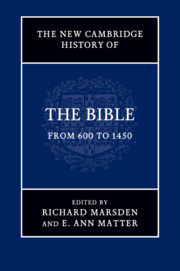Book contents
- Frontmatter
- Contents
- Figures
- Contributors
- Preface
- Abbreviations
- Abbreviations of books of the Bible
- Table of Psalm numbering
- Introduction
- Part I Texts and Versions
- 1 The Hebrew Bible
- 2 The Greek Christian Bible
- 3 Jewish Greek Bible versions
- 4 The Latin Bible, c. 600 to c. 900
- 5 The Latin Bible, c. 900 to the Council of Trent, 1546
- 6 The Bible in Ethiopic
- 7 The Bible in Arabic
- 8 The Bible in Armenian
- 9 The Bible in Georgian
- 10 The Bible in Slavonic
- 11 The Bible in Germanic
- 12 The Bible in English
- 13 The Bible in the languages of Scandinavia
- 14 The Bible in French
- 15 The Bible in Italian
- 16 The Bible in Spanish and Catalan
- Part II Format and Transmission
- Part III The Bible Interpreted
- Part IV The Bible in Use
- Part V The Bible Transformed
- Bibliography
- Index of biblical manuscripts
- Index of scriptural sources
- General index
- References
1 - The Hebrew Bible
from Part I - Texts and Versions
Published online by Cambridge University Press: 28 May 2012
- Frontmatter
- Contents
- Figures
- Contributors
- Preface
- Abbreviations
- Abbreviations of books of the Bible
- Table of Psalm numbering
- Introduction
- Part I Texts and Versions
- 1 The Hebrew Bible
- 2 The Greek Christian Bible
- 3 Jewish Greek Bible versions
- 4 The Latin Bible, c. 600 to c. 900
- 5 The Latin Bible, c. 900 to the Council of Trent, 1546
- 6 The Bible in Ethiopic
- 7 The Bible in Arabic
- 8 The Bible in Armenian
- 9 The Bible in Georgian
- 10 The Bible in Slavonic
- 11 The Bible in Germanic
- 12 The Bible in English
- 13 The Bible in the languages of Scandinavia
- 14 The Bible in French
- 15 The Bible in Italian
- 16 The Bible in Spanish and Catalan
- Part II Format and Transmission
- Part III The Bible Interpreted
- Part IV The Bible in Use
- Part V The Bible Transformed
- Bibliography
- Index of biblical manuscripts
- Index of scriptural sources
- General index
- References
Summary
The medieval period, considered here broadly to lie between the compilation of the Babylonian Talmud c. 600 ce and the end of the fifteenth century, is crucial for the history of the Hebrew Bible. The biblical canon and the tripartite classification of the twenty-four books into Law (the Torah or Pentateuch), Prophets (Nevi’im) and Hagiographa (Ketuvim) had long been established. The consonantal text, too, had been standardised well before; a large proportion of the Bible manuscripts from the Judaean desert from the beginning of the Christian era attest already to a type of consonantal text similar to that seen in later medieval manuscripts. Nonetheless, in the Middle Ages the Hebrew Bible was subject to many changes. First, the books acquired a new shape: alongside the traditional scrolls, which continued to be used in the liturgy, the biblical text was now copied in the codex format. Second, the fixed consonantal text was provided with written vowels, cantillation signs (‘accents’) and textual notes known as the Masorah (usually translated as ‘tradition’). These masoretic additions not only recorded the various traditions of pronunciation but also imposed a fixed interpretation of those words whose purely consonantal form could be read in different ways. The introduction of the vowels, together with the growing influence of philosophical and scientific debates in the Arab world, proved to be one of the essential factors leading to the development of new approaches to the biblical text – namely, the birth of grammar and lexicography and of a new type of ‘proto-scientific’ commentary distinct from the Late Antique genres of homiletic and legendary midrashim (collections of exegesis and exposition of scripture). Last but not least, the geographical spread of Jewish communities accounted for a diversity of hand-copied Bibles, which show the influence of the book-making techniques of non-Jewish neighbours.
These three aspects of the Hebrew Bible in the Middle Ages – the scroll and codex, the Masorah, and the diversity of the Bible as a book – will be the focus of this chapter. They will be preceded by a brief review of the extant corpus of medieval Bible manuscripts and their role in modern Bible editions.
- Type
- Chapter
- Information
- The New Cambridge History of the Bible , pp. 19 - 40Publisher: Cambridge University PressPrint publication year: 2012

